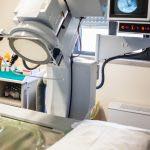Lithotripsy is a noninvasive procedure often recommended for patients with kidney stones that are too large to pass through the urinary tract. The most common form of this procedure is extracorporeal shockwave lithotripsy (ESWL), which uses high-energy shock waves to treat kidney stones (and sometimes gallbladder or liver stones). During the procedure, the patient lays on a water-filled cushion and the urologist sends targeted shock waves through the cushion to the kidney stones. This crushes the stones into pieces small enough for the patient to easily pass on their own.
The procedure is normally performed by a urologist and takes about an hour to complete. Depending on your physician’s recommendations, you may be given local or general anesthesia. You may also have the option to be sedated, instead of being given anesthesia. Either way, you won’t feel pain during your procedure. Most lithotripsy treatments are outpatient but some physicians may advise an overnight stay, depending on your health and personal situation. The recovery time is usually 1 to 2 days.
Are there alternatives to lithotripsy?
If your doctor tells you that you need lithotripsy, it’s usually because it is the least-invasive procedure that can effectively remove your type of kidney stones. There are two surgical alternatives to lithotripsy, though you’ll want to check with your doctor to see if either is a good option for you.
- Ureteroscopy — During a ureteroscopy, a thin, flexible scope is guided up the urinary tract to the kidney stone(s). The surgeon breaks up the stone(s) and removes the fragments through the tube. This procedure is commonly recommended when a stone is already out of the kidney and in the urinary tract. It is also used when lithotripsy isn’t an option due to pregnancy, blood clotting disorders, or obesity.
- Percutaneous Nephrolithotomy/Nephrolithotripsy — In this option, a surgeon makes a small incision in the patient’s back and removes the kidney stones through the opening. During a nephrolithotomy, the surgeon will remove the stones through a tube. During a nephrolithotripsy, the surgeon will use sound waves or a laser to break up the stones. They will then use a small scope to help them remove the pieces. This procedure is an option for patients with kidney stones too large or too stubborn to break up using other methods. Nephrolithotomies and nephrolithotripsies typically take one to two hours and may require an overnight hospital stay.
The type of procedure you get will depend on your personal health and your doctor’s recommendations. Don’t hesitate to ask your doctor why they’re recommending any procedure. If you’re unsure about their recommendations, feel free to get a second opinion.
How much should you pay for your lithotripsy?
Finding accurate information about the cost of your medical procedures isn’t always easy. There are many factors that can affect the price that you will pay for your lithotripsy. Fortunately, New Choice Health has gathered cost data from around the country to help you compare healthcare facilities and figure out what you should pay for your medical procedure. Visit New Choice Health’s lithotripsy cost information page to find out how to find a fair price for your procedure today.






